Last updated 19:45 on October 1st
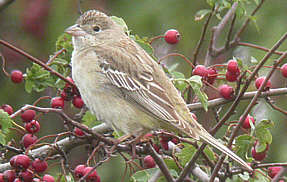
Black-headed Bunting - Gunton - 24th September 2002 - Robert Wincup.
RED-THROATED DIVER Gavia stellata
Noted past Kessingland on the 1st (1 N), 14th (1 N), 15th (3 N, 1 S), 16th (5 N, 4 S, 1 o.s.), 17th (4 N, 1 S), 18th (4 N, 2 S), 19th (4 N, 2 S), 20th (1 N, 3 S), 21st (4 N, 2 S), 22nd (3 N, 3 S), 23rd (16 N, 1 S), 24th (8 N, 2 S), 25th (2 N, 1 S), 26th (3 N), 27th (4N 3S), 28th (4N 1 o.s.), 29th (3N 2S); Ness Point 1st (2 N), 15th (2 N), 23rd (12 N); Corton 20th (1), 21st (5 N), 22nd (7 N), 27th (2 S), 28th (6 N). On the 22nd an individual close inshore at Corton was still in full summer plumage.
BLACK-THROATED DIVER Gavia arctica
One heading north from Ness Point at 11:50 passed close inshore at Corton at 12:00 on the 22nd, and one flew south at Kessingland on the 27th at 7:05.
GREAT NORTHERN DIVER Gavia immer
One flew north at Ness Point at 13:35 on the 23rd.
GREAT CRESTED GREBE Podiceps cristatus
Noted past Kessingland on the 4th (1 S), 7th (1 N), 12th (1 S); and Ness Point 13th (1 N). RED-NECKED GREBE Podiceps grisegena
Northbound birds passed Ness Point on the 1st and Kessingland on the 2nd.
FULMAR
Fulmarus glacialis
Noted past Kessingland on the 1st (38 N, 2 S), 2nd (14 N, 2 S), 3rd (15
N, 1 S), 5th (5 N, 1 S), 6th (2 N, 8 S), 7th (3 N, 8 S), 8th (3 S), 9th
(4 N, 4 S) 10th (2 S), 11th (1 S), 14th (4 N, 4 S), 15th (3 N, 1 S), 17th
(8 N), 20th (2 N), 21st (2 N), 22nd (1 N), 24th (4 N), 28th (1 N).
Ness Point: Rather small numbers northbound on the 1st considering the movement
of Shearwaters, and almost all were seen early in the morning. Also noted
on the 2nd (30 N), 3rd (7 N), 15th (10). Corton 22nd (2 N).
CORY'S
SHEARWATER Calonectris diomedea
Two flew north past Pakefield at 9:50 on the 3rd.
| SOOTY SHEARWATER Puffinus griseus | |
|
|
|
|
Pictures
- Andrew Easton (left) and Tim Brown (right).
|
These
birds were at a range of 700-800 metres
|
|
After
reports on the pagers of 87 northbound at Southwold on the 1st the
search for passerine migrants was all but abandoned, as everyone headed
for Ness Point. Between 09:00 and 19:45 the observers were not disappointed,
with the unprecedented total of 253 seen heading north. Whilst many
were as far out as the horizon, many more were between two and three
kilometres out, whilst those closer than this provided very good views.
The closest one was a mere 400 metres out. Passage was heaviest before
midday, and was quietest mid afternoon but picked up a bit later on,
and the largest group was of eight birds. A most remarkable day, and
with unusually clement weather for a good seawatch. The movement continued
on the 2nd (91 N) and 3rd (76 N), with further sightings on the 9th
(1 N) and 15th (3 N). |
|
MANX
SHEARWATER Puffinus puffinus
One flew north at Lowestoft at 16:30 on the 3rd, with three seen there on
the 9th, and another three on the 23rd. Also on the 9th five were noted
at Kessingland (2 N, 3 S), 23rd (3 N) and 24th (1 N).
BALEARIC SHEARWATER Puffinus mauretanicus
At 12:15 on the 1st one was seen accompanying three Sooty Shearwaters northbound
off Ness Point. During the day a total of nine were seen heading north,
including the final sighting of a flock of four at 18:12. A nice addition
to many of the observers' County and Lounge Lizard Lists! Six were also
noted past Kessingland on the 1st. They passed at 14:54, 18:02 (4 - same
as Ness Point), and 19:19.
EUROPEAN STORM PETREL Hydrobates pelagicus
On the 9th one flew south past Kessingland at 17:35, it was approximately
150 metres from the beach.
LEACH'S STORM PETREL Oceanodroma leucorhoa
Two flew north past Kessingland on the 2nd, one at 6:58 about 150 metres
from the beach and with the second at 10:20 within 100 metres of the beach.
On the 3rd one 14:50 flew slowly north past Kessingland within 30 metres
of the beach. Initially very low to the sea the bird occasionally dropped
almost to the surface as if feeding, after 2-3 minutes it settled on the
sea it was observed drifting slowly south on the tide for 30 minutes before
being lost to view. The individual seen at Kessingland on the 2nd at 10:20
was picked up heading north at Ness Point at 11:15.
GANNET Morus bassanus
Noted past Kessingland on the 1st (38 N, 6 S), 2nd (81 N), 3rd (210 N, 3
S), 4th (27 N), 5th (29 N, 2 S), 6th (7 N), 7th (1 N), 8th (3 N), 9th (58
N, 2 S), 10th (5 N, 1 S), 11th (1 N, 1 S), 12th (22 N, 1 S), 13th (19 N),
14th (17 N, 3 S), 15th (12 N, 4 S), 16th (44 N, 2 S), 17th (94 N, 3 S),
18th (32 N), 19th (31 N), 20th (34 N), 21st (25 N, 10 S), 22nd (57 N, 33
S), 23rd (123 N, 37 S), 24th (61 N), 25th (27 N), 26th (42 N, 27 S), 27th
(70N 6S), 28th (10N 1S), 29th (22N 6S).
Ness Point: 1st (50 N), not very many for a ten hour + seawatch, 2nd (203
N), 3rd (174 N), 9th (50+ S), 15th (18), 23rd (150 N); Corton 21st (40 N),
22nd (100 mainly S), 27th (40 N), 28th (31 N).
GREY HERON Ardea cinerea
Noted past Kessingland on the 17th (1 N), 25th (2 N); Ness Point on
the 1st (1 S); Pakefield 29th (2 N with Spoonbill) and Corton 29th (1 in
off sea, 2 N with Spoonbill).
SPOONBILL
Platalea leucorodia
A juvenile flew north in the company of two Grey Herons on the 29th,
they were first seen at Kessingland at 8:15, then at Pakefield and finally
at Corton at 8:25 where they were watched disappearing into the mist as
the group continued northwards past Gorleston. When it reached Corton, due
to it's faster flight, the Spoonbill had gained a couple of hundred of metres
on the herons, but it then performed a large right hand circuit to allow
them to catch up!
BRENT GOOSE Branta bernicla
Noted north past Kessingland on the 13th (4 N), 14th (2 N), 15th (19 N),
16th (11 N), 17th (4 N), 18th (2 N), 20th (1 N), 21st (2 N), 22nd (11 N),
23rd (85 N, 3 S), 24th (35 N, 6 S), 25th (21 N), 26th (6 N), 27th (85N 3S),
28th (8N 6S), 29th (1S); Lowestoft 13th (1), 14th (2), 15th (20), 23rd (148
N), 26th (13 N); Corton 22nd (26N), 23rd (16 N), 27th (200 N), 28th (14
N), 29th (3 S).
PINK-FOOTED GOOSE Anser brachyrhynchus
Two flew south at Ness Point on the 23rd.
SHELDUCK Tadorna tadorna
Noted past Kessingland on the 12th (5 S), 16th (4 N), 21st (4 S), 23rd (3
N), 29th (1 S); and Ness Point on the 1st (4 N) and 15th (1 N).
PINTAIL Anas acuta
Noted past Kessingland on the 14th (2 N), 17th (1 S), 22nd (6 o/s), 23rd
(2 N), 27th (12 N); Corton 13th (30 S), 21st (2 N), 22nd (4 N), 23rd (3
N), 27th (25 N), 28th (1 N).
WIGEON Anas penelope
Noted past Kessingland on the 3rd (19 S), 4th (6 S), 9th (130 S), 10th (22
S), 11th (8 S), 12th (54 S), 13th (40 S), 15th (95 N), 16th (20 N), 17th
(4 N, 8 S), 19th (20 N, 9 S), 21st (15 S), 22nd (55 N, 6 S, 20 o/s), 23rd
(19 N, 80 S), 24th (8 S), 25th (42 N), 27th (41N 10S), 28th (1N), 29th (1S);
Ness Point 9th (c150 S), 14th (50 N), 15th (144 N), 23rd (28 N); Corton
22nd (15 N), 23rd (10 S), 27th (40 N), 28th (15 N).
TEAL Anas
crecca
Noted past Kessingland on the 1st (9 N), 2nd (10 N, 210 S), 3rd (279 S),
4th (9 S), 5th (8 S), 7th (4 S), 9th (185 S), 10th (153 S), 11th (22 N,
42 S), 12th (297 S), 13th (6 N, 8 S), 14th (8 N, 9 S), 15th (40 N, 80 S),
16th (14 N), 17th (1 N, 4 S), 18th (1 N, 1 S), 19th (22 N, 12 S), 21st (9
N, 15 S), 22nd (6 N, 8 S), 24th (5 N), 25th (1 N, 3 S), 27th (18N), 28th
(3N), 29th (2S).
SHOVELER
Anas clypeata
Noted past Kessingland on the 10th (1S), 15th (1 N).
EIDER Somateria mollissima
Noted past Kessingland on the 22nd (10 S), 26th (35 N), 27th (3N), 28th
(1N). At Corton a flock of 45 flew north on the 21st.
COMMON SCOTER Melanitta nigra
Noted past Kessingland on the 1st (1 N, 5 S), 2nd (4 S), 3rd (4 N, 9
S, 10 o/s), 4th (3 S, 2 o/s), 5th (11 N, 5 S), 6th (4 S, 2 o/s), 8th (7
S), 9th (47 S), 10th (2 N 3 S), 11th (25 S, 1 o/s), 12th (2 N), 13th (10
N), 14th (4 N), 15th (7 N, 1 S), 16th (16 N), 17th (2 N), 18th (6 N), 19th
(5 N, 13 S), 20th (3 N), 21st (13 N), 22nd (5 N), 23rd (16 N), 24th (9 N,
30 S), 25th (6 N), 26th (13 N), 27th (9N 2S), 28th (9N); Ness Point 1st
(2 N), 9th (9 N), 15th (65 N), 23rd (3 N); Corton 22nd (4 N).
RED-BREASTED MERGANSER Mergus serrator
Noted past Kessingland on the 15th (1 N).
HONEY
BUZZARD Pernis apivorus
One was seen at Corton on the 20th. It flew in from the north at 16:15
before circling to the west of the Church gaining height, and then headed
off to the north.
MARSH HARRIER Circus aeruginosus
One juvenile flew north past Ness Point on the 1st, and it continued to
head north at wave top height about 500 metres out! It was also seen earlier
at Kessingland. A second bird was noted north past Kessingland on the 21st.
OSPREY Pandion haliaetus
One was seen flying over Oulton Broad at 07:00 on the 10th. Another was
watched flying south at height about 4 kilometres off Corton at 16:55 on
the 23rd.
HOBBY Falco subbuteo
Noted at Oulton Marshes on the 1st; Corton 5th, 7th, 12th, 14th, 17th; Mutford
10th; Kessingland 10th, flying south along the beach, 22nd (1 N); Gunton
20th (1). One at Corton on the 14th was sitting on the ground in a ploughed
field, with a Sparrowhawk on the ground in the same field as well, perhaps
indicating that both may have been recent immigrants resting.
GREY PARTRIDGE Perdix perdix
A covey of twelve were at Corton on the 29th.
OYSTERCATCHER Haematopus ostralegus
Noted past Ness Point on the 1st (22 S, 1 N), 3rd (2 S), 10th (4), 15th
(1 N); Kessingland 8th (2 S), 10th (4 S), 11th (2 S), 15th (11 S), 16th
(2 N), 21st (1 N, 7 S), 22nd (2 S), 24th (1 N).
GOLDEN PLOVER Pluvialis apricaria
Noted at Gorleston Golf Course on the 9th (2); Lowestoft North Denes on
the 10th (4); Corton 13th (1), 29th (1); and one flew north at Lowestoft
on the 15th.
GREY PLOVER Pluvialis squatarola
Noted past Kessingland on the 1st (1 S), 9th (125 S), 11th (1 S), 15th (1
N), 22nd (2 N).
|
TURNSTONE
Arenaria interpres |
|
KNOT
Calidris canutus
Noted past Ness Point on the 1st (12 S), 9th (c200 S); Kessingland 9th (100+
S), 15th (2 N), 22nd (15 N); Corton 16th, one flew over the MoD field.
PURPLE SANDPIPER Calidris maritima
Three were at Ness Point on the 15th.
DUNLIN Calidris alpina
Noted past Kessingland on the 10th (21 S), 13th (3 S), 14th (4 N), 16th
(6 N), 22nd (12 N), 23rd (25 N); Ness Point 15th (26 N); Corton 22nd (35
N). Two were in the MoD fields at Corton on the 10th.
COMMON SNIPE Gallinago gallinago
One was at Corton on the 21st.
JACK SNIPE Lymnocryptes minimus
One was flushed from the stubble field at Gunton disused railtrack on the 25th. Another was flushed from Bracken at Gunton Beach on the 28th by birders trying to relocate an elusive Dartford Warbler!
BLACK-TAILED GODWIT Limosa limosa
Noted past Pakefield on the 10th (1 S).
BAR-TAILED GODWIT Limosa lapponica
Noted past Kessingland on the 1st (25 S), 3rd (15 S), 5th (4 S), 7th (3 S), 9th (14 S), 10th (1 S). A flock of 67 flew south past Ness Point on the 1st.
WHIMBREL
Numenius phaeopus
Noted past Kessingland on the 1st (5 S), 5th (1 S), 6th (1 S), 8th (1 S);
Ness Point on the 1st (3 S, 1 N).
CURLEW Numenius arquata
Noted past Kessingland on the 4th (1 S), 10th (1 N), 12th (1 N), 18th (1
N), 22nd (2 N).
REDSHANK Tringa totanus
Noted past Kessingland
on the 1st (1 S), 5th (1 S), 6th (1 S), 11th (1 N). Flocks of 39 and 6 flew
south high over Hamilton Dock on the 1st.
COMMON SANDPIPER Actitis
hypoleucos
Singles were at Hamilton Dock and Ness Point on the 1st. A flock of 14 were
on groynes at Corton on the 10th.
GREAT SKUA Catharacta
skua
Noted past Kessingland on the 1st (3 N), 3rd (1 N), 9th (1 N, 5 S),
13th (1 N), 19th (1 N), 23rd (3 N); Ness Point 1st (2 N, 1 S), 2nd (2 N),
9th (3 S), 23rd (1 S); Pakefield 3rd (1); Corton 21st (1 N), 22nd (2 S).
POMARINE
SKUA Stercorarius pomarinus
Noted past Kessingland on the 1st (1 N), 2nd (1 N), 8th (1 S), 14th (1 N),
15th (2 N), 17th (1 N), 19th (1 N), 21st (1 attacking gulls offshore), 23rd
(1 N); Ness Point 2nd (1 - same as Kessingland), 7th (1), 29th (1 N); Pakefield
3rd (1); Corton 22nd (1 S).
ARCTIC SKUA Stercorarius parasiticus
Noted past Kessingland on the 1st (2 N), 2nd (2 N), 3rd (4 S), 9th (3 N,
1 S), 14th (2 N), 15th (5 N, 2 S), 17th (2 N), 18th (1 N), 19th (2 N), 22nd
(1 N, 6 S), 23rd (14 N), 24th (2 N), 28th (1 N); Ness Point 1st (7 N), 2nd
(8 N, 5 S), 3rd (3 N), 9th (7 S), 15th (2 N), 23rd (8 N, 2 S); Pakefield
3rd (2); Corton 10th (1 S), 21st (2 N), 22nd (13 S).
LONG-TAILED SKUA Stercorarius longicaudus
Two passed Kessingland at 9:45 on the 12th. These elegant birds were shearing
south in a force 5 NNE'ly wind and were about km offshore. Three light morph
juveniles were seen from Corton on the 22nd. The first was heading north
at 8:40, with the other two south in the afternoon at 13:10 and 16:35. The
third bird was seen with an Arctic which gave an ideal comparison of size
and structure. What was presumably the same bird was seen further down the
coast at Southwold half-an-hour later at 17:05. In an amazing two-minute
spell four species of skua were seen. Four more were seen passing north
early morning on the 23rd at Ness Point (2 N), Pakefield (1 N) and Kessingland
(1 N).
SKUA Spp.
Probable Long-tails were noted at Kessingland on the 15th, when three lightly
built skuas flew south, and at Corton on the 22nd when two others did likewise
during the afternoon. On the 1st a distant skua flew north past Kessingland.
Other unidentifiables were noted on the 21st and 22nd.
MEDITERRANEAN GULL Larus melanocephalus
Noted past Kessingland on the 3rd (1 N), 20th (1 S) and Corton 10th (ad
S).
|
LITTLE
GULL Larus minutus |
.Ness Point:
15th (4 N); Corton 17th (3), 21st (1 S), 23rd (27 N), 27th (3 N),
28th (18 N). |
Noted past Kessingland on the 2nd (5 N), 3rd (5 N), 5th (1 S), 9th (3 N), 23rd (75 N), 24th (2 N).
YELLOW-LEGGED GULL Larus michahellis
The regular adult was again on groynes along Lowestoft North Beach on the 1st, 26th, 28th, 29th.
SANDWICH TERN Sterna sandvichensis
At least five were seen at Corton on the 23rd (3 N, 2 S).
ARCTIC TERN Sterna paradisaea
Juveniles flew north at Ness Point on the 14th and 15th. One flew south past Corton on the 22nd.
BLACK TERN Chlidonias niger
Two flew south past Kessingland on the 9th, and five were seen at Ness Point at midday on the 11th.
GUILLEMOT Uria aalge
Noted past Ness Point on the 9th (1 N), 15th (4 N). Two swam south close inshore at Corton on the 14th, with another there on the 15th.
One flew north at Ness Point on the 23rd.
PUFFIN Fratercula arctica
On the 23rd a Puffin flew past Kessingland accompanying a Guillemot. The differences in size and flight were clear as the pair alternated the lead position whilst heading north. On the 24th a singleton flew north at the same location.
AUK Sp. Alcidae
Noted past Kessingland on the 1st (2 N), 2nd (1 N), 3rd (3 S), 6th (1 o/s), 10th (1 S), 12th (1 S), 13th (1 S), 14th (1 N), 15th (3 N), 16th (1 N), 17th (4 N, 2 o.s.), 18th (3 N), 19th (3 N), 20th (1 N), 21st (4 N), 22nd (2 N), 23rd (22 N), 24th (21 N), 25th (2 N), 27th (2 N), 28th (2 N); Ness Point 15th (10 N), 23rd (10 N); Corton 23rd (2 N), 28th (3 N).
TAWNY OWL Strix aluco
One was showing very well at roost in Belle Vue Park on the 15th. Another was calling in the Water Lane, Lowestoft area at night on the 18th.
SHORT-EARED OWL Asio flammeus
One arrived off the sea at Corton on the 22nd at 11:40.
SWIFT Apus apus
Singles flew flew south over Corton on the 7th and Gunton on the 10th.
KINGFISHER Alcedo atthis
One was along Lake Lothing from Elmham Terrace on the 8th and Mutford Lock on the 10th.
HOOPOE
Upupa epops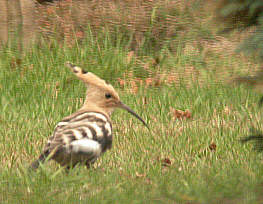 |
It was only a few hundred metres from the garden the April 2000 individual was in. Hopefully the next one will chose a rather more accessible location. Picture - Robert Wincup |
WRYNECK Jynx torquilla
One was seen feeding on top of the wartime pillbox along Gunton disused railway line on the morning of the 6th, but was not seen afterwards.
HOUSE MARTIN Delichon urbica
c60 were feeding over Lowestoft North Denes early morning on the 4th with 200 at Corton later in the day. Early morning on the 29th saw a very large southbound movement with at least 1791 counted over Corton. Only a handful each of Swallow and Sand Martin were seen with them!
MEADOW PIPIT Anthus pratensis
Good numbers were at Corton, c400 on the 17th, but by the 20th had decreased to c100.
TREE PIPIT Anthus trivialis
Noted at Gorleston Golf Course 9th (1); Hopton/Corton 9th (2), 10th (5), 12th (1), 14th (5); Lowestoft Cemetery 10th (5), 11th (2), 12th (1); Lowestoft North Denes 10th (8), 12th (1), 14th (2); Gunton 10th (5), 13th (1), 14th (1), 15th (1); Warrenhouse Wood 11th (1), 12th (1); Kessingland 11th (1).
ROCK PIPIT Anthus petrosus
One was at Ness Point on the 15th before flying south towards the harbour. Noted at Corton on the 17th (1), 20th (2), 21st (1).
YELLOW WAGTAIL Motacilla flava
Noted at Corton on the 4th (1), 7th (1), 10th (1), 21st (1 N); Gunton 10th (2), 24th (2); Lowestoft Cemetery 10th (1); Pakefield 10th (1), 29th (2); Lowestoft North Denes 12th (1).
GREY WAGTAIL Motacilla cinerea
Noted at Gunton 10th (2 S), 28th (2); Lowestoft 10th (1 S), 22nd (2 N); Kessingland Sluice 11th (1); Corton 13th (2 S), 14th (1), 16th (3), 17th (1), 19th (1), 20th (9), 21st (5 N), 22nd (8 N), 25th (2), 26th (2), 28th (2), 29th (3); Sparrows Nest Park 15th (1); St. Olaves 28th (1).
REDSTART Phoenicurus phoenicurus
Noted at Gunton 10th (2), 12th (2), 13th (1), 21st (1), 23rd (3); Corton 10th (3), 11th (2), 13th (2), 14th (3), 15th (1), 16th (2), 17th (1), 29th (1); Lowestoft Cemetery 10th (1); Lowestoft North Denes 12th (1); Belle Vue Park 15th (1).
|
NORTHERN
WHEATEAR Oenanthe oenanthe |
|
|
WHINCHAT
Saxicola rubetra |
|
STONECHAT
Saxicola torquata
Five newly arrived birds in Lowestoft on the 28th, at the same time as a
Dartford Warbler strongly suggests that our wintering population originates
from the Suffolk Sandlings just a few miles to the south. Whereas previously
we'd assumed that they'd arrived from the north. After the first autumn
birds at Corton on the 20th (2) subsequently recorded at Kessingland Beach
25th (2); Corton 21st, 22nd, 26th (2), 29th (4); Lowestoft North Denes 28th
and 29th (1); Gunton Beach 28th (4), 29th (3).
REDWING Turdus iliacus
The first returning bird of the autumn was seen at Hopton on the 10th. Two,
possibly three, were at Pakefield on the 14th, with another at Hopton the
same day.
REED WARBLER Acrocephalus scirpaceus
Singletons were at Corton on the 15th and 22nd; and at Pakefield on the
29th.
ICTERINE WARBLER Hippolais icterina
One was found in Belle Vue Park on the 14th, it proved elusive much
of the time, but by late afternoon was showing well in the canopy of a Holm
Oak near the roofless shelter. It was seen well again early morning on the
15th in the same tree, but was apparently not seen after this.
DARTFORD WARBLER Sylvia undata
Following the recolonisation of the species in Suffolk in the late 1990's
it was only a matter of time before post breeding dispersal led to one venturing
north into the Lowestoft area. And on the 28th one did indeed turn up in
the company of three newly arrived Stonechats at Gunton Beach. As normal
it was an elusive little tyke at times but did perch on top of brambles
on one or two occasions, and was still present and just as elusive on the
29th and 30th.
BARRED WARBLER Sylvia nisoria
A juvenile was found in scrub in the south-east corner of Gorleston golf
course at 18:25 on the 4th.
WOOD WARBLER Phylloscopus sibilatrix
Two were present along Corton disused railway line from the 21st-22nd. On
a couple of occasions on the first day they were in the same tree as a Yellow-browed
Warbler, but never for too long, see below. On the 22nd they were difficult
to find, remaining high up in the trees in blustery conditions. One there
on the 25th was presumably one of these earlier birds.
YELLOW-BROWED WARBLER Phylloscopus inornatus
One at Gunton on the 16th became Lowestoft's earliest record by one day.
It was found in a roving tit flock working its way west along Hubbard's
Loke. The flock continued towards Gunton Woods and were not relocated. The
second was at Corton disused railway line on the 21st, a more typical date.
It remained elusive despite spending almost the entire afternoon in a single
Holm Oak. It was mainly seen when one of two Wood Warblers or a Chiffchaff
also present ventured into 'its' tree. When they did the Yellow-browed would
start calling and instantly chase the other warblers. It would then become
silent until something else dare enter the tree. Birders looking for the
departed Black-headed Bunting found one along Gunton disused railtrack on
the 26th. It was calling frequently and was seen in the tall Sycamores at
the northern end of the railtrack. Click here
for more details on the occurrence of Yellow-browed and Pallas's Warblers
Phylloscopus proregulus in Lowestoft.
CHIFFCHAFF Phylloscopus collybita / WILLOW
WARBLER Phylloscopus trochilus
Considering the fairly large numbers of migrants around Chiffchaffs
and Willow Warblers have been noticeable by their almost complete absence!
One Willow Warbler was in song at Corton on the 16th.
FIRECREST Regulus ignicapillus
These mercurial little birds were seen at Belle Vue Park from the 11th-14th;
Corton 25th (2) with one remaining until the 27th; Kirkley Cemetery 27th
(1).
|
|
SPOTTED
FLYCATCHER Muscicapa striata |
PIED
FLYCATCHER Ficedula
hypoleuca
Exceptional numbers arrived on the 9th/10th. The totals represented for
these dates are no doubt conservative counts. Noted at Corton on the 4th
(1), 10th (21), 11th (3), 12th (5), 13th (2), 15th (2), 16th (1), 21st (1);
Lowestoft North Denes/Flycatcher Lane 4th (1), 10th (8), 11th (1); Belle
Vue Park/Sparrow's Nest Gardens 4th (3), 10th (15), 11th (1), 12th (1),
14th (4), 15th (5); Gunton 9th (1) 10th (21), 12th (3), 16th (3); Gorleston
Golf Course 9th (4); Kessingland 9th (1), Pakefield 9th (1), 10th (5), 14th
(1); Lowestoft Cemetery 10th (6), 11th (1), 12th (2); Warrenhouse Wood 11th
(3), 14th (1), 15th (1), 20th (1); St Margarets Church 11th (3).
BEARDED TIT Panurus
biarmicus
A lone male was found perched on a Hawthorn bush along Gunton disused railway
line on the 30th. They do turn up in some unexpected places when post breeding
dispersal takes place, usually after a good breeding season.
|
RED-BACKED
SHRIKE Lanius collurio |
The third bird of the autumn, a juvenile, was in bushes below
the CEFAS buildings at Pakefield on the 1st, and the fourth was at
Corton near the old wartime pillbox south of Radar Lodge on the 9th-12th.
On the 10th it was also seen in the former MOD complex. |
JAY Garrulus glandarius
Three arrived, high, off the sea at Gunton on the 26th.
BRAMBLING Fringilla montifringilla
The first of the autumn migration flew south over Corton on the 22nd, with one seen in Corton Woods on the 23rd. Two were in Water Lane, central Lowestoft on the 28th.
REDPOLL Carduelis flammea
A fly-over was noted at Gunton on the 24th.
SISKIN Carduelis spinus
Fly-overs noted at Corton on the 22nd, 26th, 28th.
CROSSBILL
Loxia curvirostra
Five flew over Roman Hill, Lowestoft on the 13th and two flew over Belle
Vue Park on the 14th and 15th.
LAPLAND BUNTING Calcarius lapponicus
One was seen
in flying north and heard calling at Corton MoD on the 21st.
REED BUNTING Emberiza
schoeniclus
Noted on Lowestoft North Denes on the 10th; Corton on the 17th, 29th (2);
and Gunton on the 24th.
|
BLACK-HEADED
BUNTING Emberiza melanocephala |
|
 |
As can be seen in the picture above all, but the outer two, juvenile median coverts, and the two inner greater wing coverts have already been replaced by adult type ones. The rest of the plumage would normally be moulted on the wintering grounds. Pictures -
Copies of these pictures are available for £2.00 + p&p by
emailling Tim Brown. |
Escapes
DIAMOND DOVE Geopelia
cuneata
An immaculately plumaged male example of this tiny Australian pigeon was
at Gunton on the 13th.
|
Other
Wildlife
|
|
|


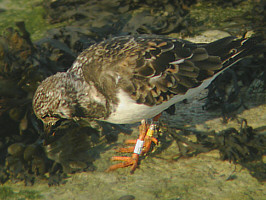
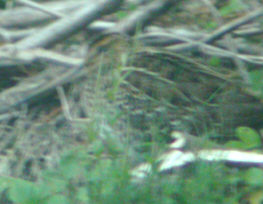
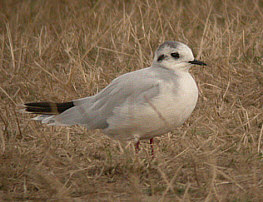 Picture - Robert Wincup.
Picture - Robert Wincup.
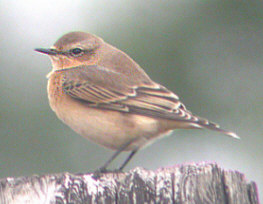
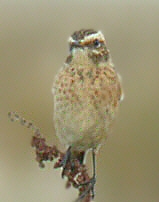 Picture - Robert Wilton.
Picture - Robert Wilton.



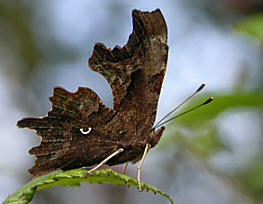 At
least two Harbour Porpoise Phocoena phocoena and a Grey
Seal Halichoerus grypus were feeding close inshore at Ness
Point on the 1st.
A Grey
Seal was found washed up dead on Lowestoft North Beach on the
4th. A single Muntjac Deer Muntiacus reevesi was seen
crossing the road at Corton Woods on the 10th and a pair were feeding
on the slope behind the Denes Oval on the 15th. Two Harbour Porpoise
and two Grey Seals were seen at Corton on the 22nd.
At
least two Harbour Porpoise Phocoena phocoena and a Grey
Seal Halichoerus grypus were feeding close inshore at Ness
Point on the 1st.
A Grey
Seal was found washed up dead on Lowestoft North Beach on the
4th. A single Muntjac Deer Muntiacus reevesi was seen
crossing the road at Corton Woods on the 10th and a pair were feeding
on the slope behind the Denes Oval on the 15th. Two Harbour Porpoise
and two Grey Seals were seen at Corton on the 22nd.